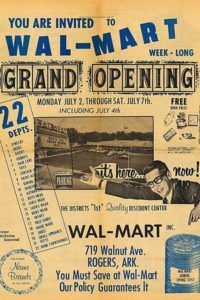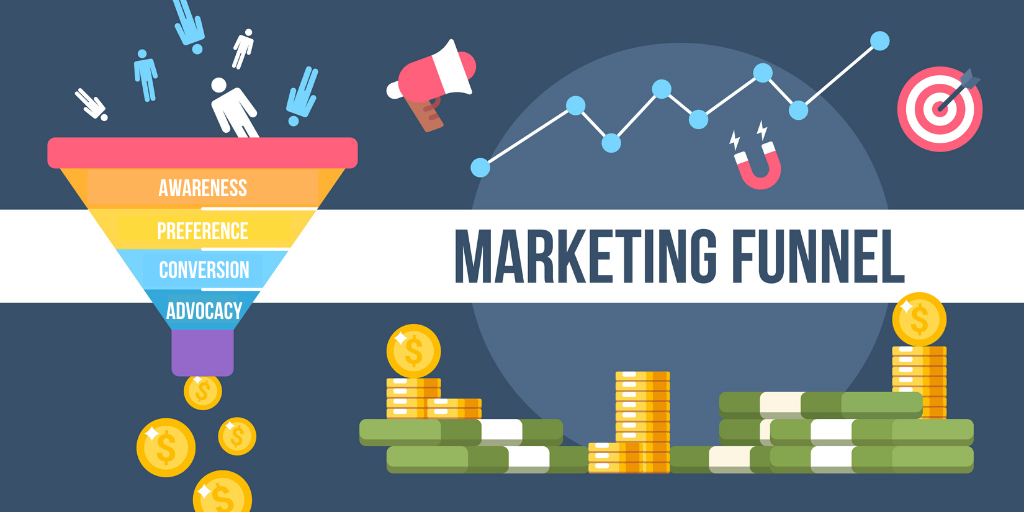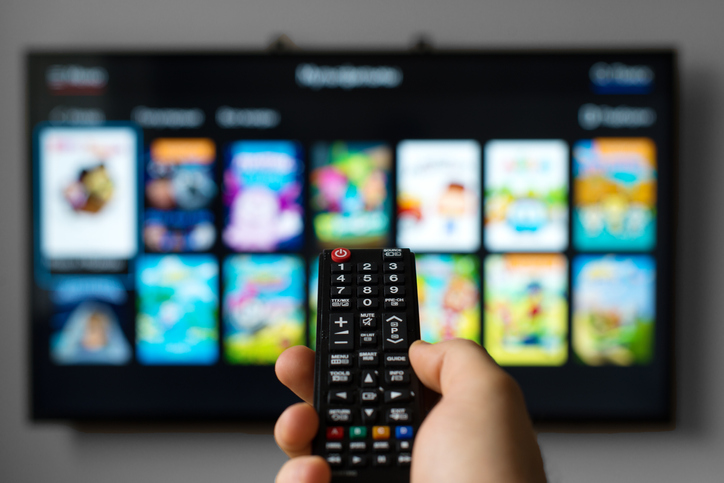If you’ve ever thought about creating a formal marketing plan for your Pennsylvania company, you’ve probably run into the term “marketing funnel” or “marketing sales funnel.” While almost all modern communications plans use some type of marketing funnel, this is not a new term.
In fact, most experts attribute the first use of “marketing funnel” to an ad agency exec in 1898. Over a century ago, Elias St. Elmo mapped out the marketing journey as a tool to get new advertising clients. He was the first advertiser to sort the customer’s journey into distinct stages.
Since then, the marketing funnel has been reimagined and labeled in many different ways. The concept of the marketing funnel, sometimes called a purchasing funnel or a marketing sales funnel, has lasted so long because it is a relatively simple, easy-to-understand visualization of the hypothetical journey a customer takes.
Even though the marketing funnel has become a well-established communications tool over time, many small businesses today don’t take time to develop a marketing funnel strategy. That can be a mistake. This tried and true marketing tool can help almost any Lancaster County business think about ways to convert a person into a lead, a lead into a sale, and a purchase into a repeat customer. When you visualize the marketing funnel and map out plans for each part of the process, you realize that to get sales, you must begin by building awareness.
Like it or not, every customer starts out as someone who knows nothing about your business. They may not recognize your logo, see where you’re located, understand what you do, or know anything about you or your products or services. However, to be successful, any business or organization must convert people with no knowledge into a repeat customer, and that can be quite a task. Lancaster companies must know how to create relevant and compelling communications, offers, and interactions, and then deliver them at the right time to the right audiences.
Awareness, Preference, Conversion, and Advocacy
Here’s where the marketing funnel can help. The stages of the business funnel are awareness, preference, conversion, and advocacy. When you spend time thinking through your marketing funnel, what your best customers will do at each stage, and how long they will spend at each stage, it will become clearer how to fund each stage appropriately. You’ll also find out which areas you already have covered, and which areas need more work. You’ll understand where you need to spend money to improve a stage, and which stages are already working well.
When you spend time developing and analyzing your marketing sales funnel, you’re actually spending time developing and analyzing your business. You are thinking about what you need to do to get more customers through the door, and how to get them to use you again and again. When used effectively, a well-managed marketing funnel serves as a road map that shows how a business can turn leads into customers and turn a one-time purchaser into a loyal consumer.
While a marketing funnel provides a neat, easy-to-understand graphic guide that illustrates the stages your customer goes through, it’s essential to understand that this journey is rarely linear. Few customers “fall” through the funnel predictably or in perfect order. Every customer does not fully experience every stage or even go through the stages in the desired order.
For example, some Pennsylvania customers go through the funnel in minutes. For some restaurants, the prospect may go through the marketing funnel quickly. One night they may get hungry (where am I going to eat right now?), do a quick “near me” search on Google (awareness), make a decision based on an online menu or website (preference), and call to order a pizza for pick up (conversion.) If they tell their friends how good the restaurant is, they continue to promote the business (advocacy.)
In other situations, it may take months for a customer to consider a purchase. For example, they may think about buying a new car for months and see several ads from many dealerships during that time (awareness and preference) before they visit a dealer’s lot (conversion.) And if they send their friends or family to that dealership in the coming months, that’s advocacy.
In another example, a person may consider joining a gym to get fit. They may become aware of a nearby gym, see the fees, and move on. In the meantime, they may begin a workout routine, and access blogs and information available for free on that gym’s website. They may subscribe to the gym’s free e-newsletter and workout tips emails. They may see ads for the gym on their social media feed. Even though they have not paid for anything yet, they recommend the gym to a few friends, who become members. At last, the person sees ads for joining for one month free with a 12-month membership and decides to join his friends, make the investment, and join the gym.
In the last example, the person experiences awareness, then preference, then advocacy, and lastly, conversion. They don’t move through the funnel predictably. Still, all of the communications they received while in the funnel helped them decide to purchase, and also resulted in two additional memberships.
As you can see in this range of examples, different people spend different amounts of time in each part of the funnel. Various business models must look at the marketing funnel differently. That’s why it’s so important to spend time thinking through the kinds of experiences your prospects may have in each stage. When you spend this time working on the funnel, you are making sure it’s easy for your audiences to find you. You also want to provide enough information for customers to understand why they should choose you over your competitors. Of course, you should make buying as easy as possible. And finally, you must ensure you have tools in place to transform a first-time buyer into a repeat customer and to transform a customer into an advocate for your business. With planning and the right marketing tools, you can help your Lancaster County customer move to the next stage when the time is right.
Make the Most of Every Stage in the Funnel – Online and Offline
No matter how big and famous your business is, every person must have some initial experience with it. For companies like McDonald’s, many people discover the chain as a child and don’t remember the first time they heard about it. For other businesses like a daycare center, people are only receptive to remembering their options once they need those services. For different types of companies with low-risk purchases, like restaurants and taverns, people are open to trying places that are close by, even if they’ve never heard of them. No matter which kind of business or organization you have, you probably know that new customers rarely spend time to find and research your product or services. Most customers will gravitate toward familiar names when they need to choose a business. To make matters more complicated, it’s likely that you have competition. Your company is just one choice of many in your category in Lancaster, or even in Pennsylvania, all competing for your prospects’ attention.
According to Crystal McFerran in Forbes.com,
“The marketing funnel starts with general awareness, and then you foster interest. But how much desire is there at that point? Your prospective lead can be all over the place for this process, so how much are they worth to you? If you know there is desire, it can be worth spending resources. But if they just want to browse, do you break out the samples and the goodwill, or do you wait to see what develops?”
While making decisions on how to handle prospects in each stage of the funnel can be challenging, when you place your messages in the right place at the right time, your prospects begin investigating their options, and you’ll want to stand out, get attention, and ensure they understand your value.
At each stage in the funnel, you want to offer them the right amount of information. For some, that may be as simple as making sure your business and offerings appear at the top of a Google search, especially when people are searching specifically for businesses within Lancaster County. Other types of businesses will need to supply deeply technical information that helps prospects understand the benefits of a substantial investment. However, no matter what you sell or who you sell to, once your customer understands who you are and what you have to offer, they need less and less information to lead them to the conversion, or sales, stage of the funnel.
To increase awareness, it helps to think about context. If you are placing an ad, what kind of editorial content surrounds it? Is this content that people trust and spend time with? Does putting your ad in this format make sense with your product and offerings?
According to Matthew Broughton on ExchangeWire.com,
“If ads are genuinely relevant to content, they are more effective. We know, for instance, that contextual alignment can drive up to 50% higher ad recall, according to Google’s 2017 Market Insights study in EMEA.”
For example, running ads about sports equipment in the sports section of LNP makes more sense than running that ad in a wedding magazine. Online, a Pennsylvania bank may want to avoid placing ads on a gambling website but may wish to allocate more funds to placing digital ads on the financial news section of LancasterOnline. Bakeries may not want ads to run alongside content that bashes carbs.
Once you decide where your ad should be to gain awareness, you must determine what message you want to convey to achieve preference. In the early stages, it may make sense to use emotion to capture their attention. Can you create messages or offers that make your potential customers feel a certain way? Can you position your product or service as a pathway to belonging to a specific group, such as smart investors, health-conscious eaters, or serious athletes? Can you help them understand how your product will help them avoid undesirable emotions such as anxiety or fear?
Once you get their attention, it’s time to use logic to prove that you’re good at what you do and that your company can deliver on your promises. Websites, social media sites, videos, brochures, testimonials, and guarantees are all tools that help people research and trust your company and your offerings.
Price, placement, and promotion will help you make the sale. If you can provide a positive sales process, at the right price, with the right offer, you may be able to seal the deal. But you’re not done yet. Once you complete the conversion, you want to retain your customers, so they will come back again and again and refer others to your organization.
Of course, your organization must provide exceptional service and deliver on your promises, and make the case that you are better than competing organizations in Lancaster County and Pennsylvania. But it also helps to do things like offer discounts for repeat customers, give preferential treatment to loyal consumers, offer discounts for referrals, create promotional offers, and send out important news and information to your loyal customers to stay top of mind.
In this article, we’ll break down each part of the funnel, and give you practical advice to help you make the most of your customer’s journey.
Early in the Marketing Funnel; Create Awareness
Awareness is at the top of the funnel for a good reason. It represents how familiar your audience is with your product or service. Like it or not, today’s consumers rely on extensive research and others’ opinions before making a purchase. That means that brand awareness is critical if you want to stand out in a consideration set. Once potential customers recognize your brand, they’re more likely to make purchases and repeat purchases with little or no additional research. High levels of awareness alone actually create trust and loyalty.
According to JJ Tyson in Business2Community.com,
“Research shows that consumers trust brands more that have consistent messaging. Additionally, people like knowing that they’re using products that their peers are using… By increasing brand recognition, you’re also increasing the likelihood that others will want to talk about your product in a natural setting.”
Brand awareness can create trust by creating logical associations that confirm your company’s credibility and proficiency. It’s no coincidence that some of the best-known products or services are also some of the most trusted. When you think of Citizens Bank, Sheetz, Microsoft, and even Snickers, you don’t question their skills or abilities, even if you’re not a current patron.
In Psychology Today, Deborah Ward reports,
“Studies have shown that we are attracted to what is familiar to us, and that repeated exposure to certain people will increase our attraction toward them.”
While this article is focused on personal relationships, humans are hard-wired to be attracted to familiarity, and this is not limited to familiarity with people. Humans are also more likely to trust inanimate objects, businesses, or concepts that they are familiar with, and advertisements are no exception. When we become familiar with a company, product, or service through repeated exposure, our probability of preference skyrockets. And, don’t forget that locality plays a role in our preferences. Ensuring that local consumers also know your business is located locally, in Lancaster County, will also build preference.
While paid ads are one way to increase your target audience’s familiarity with your brand, pleasant experiences, good associations, and positive perceptions will also build familiarity and preference. That means that having articles published that are relevant to your Lancaster County business can boost awareness, but it doesn’t stop there. Ranking high in Google search, showing up on search engines, being referenced on other websites, being a sponsor of events, offering free samples, participating in festivals or community events, using branded company vehicles, ensuring highly-visible street signage, and even investing in company wearables can all increase your business’s visibility and awareness among your audiences.
Of course, paid advertising is an effective way to control the frequency and precision of your marketing messages. With paid advertising, you know who is seeing your message and how often they are viewing it. You will be able to select audiences that are more likely to convert into sales, instead of spending time and money building awareness among people who are unlikely to buy. After all, if you want to create awareness for a retirement community, it makes little sense to place ads in vehicles that are read by high schoolers. Conversely, why run ads for teen acne medication in business publications targeted to senior executives? You’ll get more impact, recognition, and recall if you run ads to relevant audiences.
Frequency is also a powerful tool for building awareness. A Pennsylvania business can’t significantly increase awareness of a travel offer by running one or two advertisements on Facebook. That’s why successful travel companies like Travelocity are continually running campaigns on social media. In another example, just one employment ad from an otherwise unknown company may motivate a few people to apply, but a series of advertisements for a well-known company ensures a larger pool of better-qualified applicants.
How to Increase Awareness
Want more ways to create the kind of real brand awareness that will make a lasting impact with your audience? Try LancasterOnline advertising to find local audiences and compatible content to one of the biggest audiences in Lancaster County. Ad choices include mobile ads, sliding billboards, homepage takeovers, sponsorships, collaborative content, and business directory packages.
Another way to increase awareness is to work towards getting the top rankings for your business’s relevant keywords on search engines like Google. Using Search Engine Optimization (SEO) techniques and strategies can help your Lancaster County business become more visible, increase click-throughs on your listing, and raise awareness of your organization. Paid search ads ensure that your business shows up at the top of the search page, building awareness and increasing click-through rates (CTR.)
In fact, according to research by Backlinko.com,
“The #1 result in Google gets 31.7% of all clicks … On average, moving up 1 spot in the search results will increase CTR by 30.8%. However, this depends on where you’re moving from and to. Moving from position #3 to position #2 will usually result in a significant CTR boost. However, moving from #10 to #9 doesn’t make a statistically significant difference.”
You can also build awareness with video ads, social media posts, and social media ads on Facebook, Instagram, LinkedIn, Twitter, and YouTube. With digital campaigns, you can even target your audiences based on a location and deliver mobile ads to people within a small radius of any geography, almost anywhere in the world. Called geo-targeting, this technique allows a business to send promotional offers to people in their parking lot, or people the parking lots of their competitors.
Leverage the Middle of the Marketing Funnel; Create Preference
Once you understand how to create awareness, it’s time to explore ways to establish preference. After all, your customers will probably be aware of more than one of your competitors. For example, car shoppers have heard of many major auto brands and may even be familiar with many local dealerships. If a dealership wants to get Lancaster County buyers to their showroom, they’ll have to give their consumers the information they need to make decisions. Dealerships must create messages that build or reinforce credibility and trust.
One way to build preference is to create messages that are relevant and helpful to the consumer. People shopping for a new car face common dilemmas, including price, financing, warranties, style, service, and availability. If a Pennsylvania dealership can address any of these in their communications, the dealership may become more relevant to certain types of people and which means those people will pay more attention to their ads.
A Lancaster County salon that caters to young, funky clients should create different messages and ads than salons that specialize in bridal parties. Some Central PA electricians can deliver service anytime night or day, while others are set up to serve the needs of large commercial clients.
The goal is to think about your audience and spend time considering the things that they want or need from your type of business. What features or benefits are most important to them? You might want to interview some existing customers to find out why they chose your company. Or you can even talk to people who are likely to use your business and see what they want or need from your industry. Spend time talking to non-customers to get different perspectives. Once you have identified their needs, match those needs with the products or services that you can deliver consistently. See how you can take the things your organization does well and pair them to the needs of your potential customers.
One of the tricks to a successful business proposition is focus and selectivity. Choose one thing that you do well and resist the temptation to talk about everything you do. Don’t try to be all things to all people. Instead, be prepared to omit messages about some of the other things you do. It’s hard enough to create awareness about one specialty, so focusing on one thing makes it easier for you to capture the attention of new customers. For example, a pizza shop may brag about offering the best wod-fired margherita pizza in town. Sure, they may also sell calzones, salads, and lots of other kinds of pizza, but they shouldn’t talk about everything in an ad. Which message is most effective?
“We have the best wood-fired margherita pizza in Lancaster.”
or
“We have the best pepperoni pizza, calzones, and salads in Lancaster. And lots of other great pizza too!”
As you can see in this example, if you’re not willing to focus on one really great thing about your business, it will be much harder to stand out. You message will also be harder to remember. And that means your advertising dollars may be less effective.
While this may seem like a scary strategy, it’s not hard to find examples of successful businesses that stick to one message. Some of the biggest companies in the world have built their empires based on one or two attributes. Fed Ex was built on reliable speed; when it absolutely, positively has to be there overnight. Geico makes it easy to apply for insurance; 15 minutes or less can save you 15 percent on car insurance. Wal-Mart delivers low price; save money, live better.
While it seems hard for small businesses to do what these mega-brands have done, remember that it is not easy for mega-brands to stay on topic. After all, even Wal-Mart had to figure out its brand positioning. Their first print ad ever published, way back in 1962, did not look like the first ad for the world’s biggest retailer.
According to Jim Edwards for Business Insider,
“Even though the company is a master marketer, it paid little attention to the design of its logos until 1992—long after other retail chains realized that consumers were both interested and delighted by well-designed shopping environments.”
 No matter how big or small your Lancaster County business is, when you know more about your customers, it becomes easier to develop messages that create preference. Whether you want to be known for discount prices, luxury goods, exceptional facilities, white-glove service, location, vast selection, industry expertise, or fast service, focusing on one element of your offerings makes it easier to communicate your point of difference successfully. That means that it’s also easier for customers to understand and retain your message, which increases awareness, and amplifies preference.
No matter how big or small your Lancaster County business is, when you know more about your customers, it becomes easier to develop messages that create preference. Whether you want to be known for discount prices, luxury goods, exceptional facilities, white-glove service, location, vast selection, industry expertise, or fast service, focusing on one element of your offerings makes it easier to communicate your point of difference successfully. That means that it’s also easier for customers to understand and retain your message, which increases awareness, and amplifies preference.
When it comes time to create effective, focused messages, video ads are a great place to start. Video ads may become one of the most effective tools in your marketing arsenal. Make sure your videos have high production value, stunning visuals, and smart messaging to capture attention and create preference
LancasterOnline advertising is also an effective place to create preference. Display formats in mobile ads, sliding billboards, and homepage takeovers allow you the visual space you need to communicate your company’s point of difference. Most formats can accommodate video, animation, and still images.
LancasterOnline also offers collaborative content. These advertorial-type articles can dig into your business’s point of differentiation, the products you sell, and even your company’s social values using the same professional writers and photographers that create content for other parts of LancasterOnline. Other types of collaborative content may include sweepstakes, quizzes, and giveaways.
Next in the Funnel: Conversions
Let’s be honest. Everything you’ve done up until now has been for one reason – to get conversions. This is where all your marketing efforts pay off. Whether a conversion is a sale, a contract, a donation, or a membership, it’s the goal of marketing. A conversion is an action you want your customers to make.
Once you have made your audience aware of your offering, and you have gained their trust, it’s time to convert. For some Central PA businesses, this may be a visit to a dealership. Other organizations may want audiences to donate to a cause or vote for a politician. Banks want people to open a checking account. Bakeries need people to buy a doughnut. Still other business models want people to order online, visit a store, enroll a child in sports, make an appointment, adopt a pet, and more.
No matter which type of conversion you’re looking for, you’re more likely to reach your goal if you can keep the prospect engaged, and you can keep the conversation going. One of the most attractive features of online advertising is that it offers many tools you can use to solicit interim commitments. While you may not be willing or able to get a sale online right away, you can take advantage of the moment they see your ad to make sure it’s easy for them to take action in the future. You may also be able to capture their information so you can remind them to take action later in the process.
Online ads are clickable, which means that you can drive people to your website or to a custom landing page with a form to collect information from interested potential customers. If you have an e-commerce business, your digital ad can click right through to an online product page where people can complete the purchase on the spot.
In other examples, a grocery store can offer a coupon for a free item to be redeemed when they buy $20 or more in groceries. A nonprofit could create a landing page that asks people to sign up for the e-newsletter. Once the nonprofit has the email, they can follow up with regular solicitations.
Advocacy: Retaining Customers and Creating Fans
As you can see, creating a new sale is a lot of work. Most Pennsylvania business owners know that getting new customers is one of their most significant expenses. Once you have a new patron, you should have a plan in place that ensures they are happy with your services, intend to use you again, and are likely to recommend you to a friend.
How valuable are repeat customers? According to ConstantContact.com,
“If you’re a small business, you need to save money anywhere you can. It costs five times more to acquire a new customer than it does to keep a current customer. Bringing that new customer to the spending level of your current customers costs 16 times more... By increasing customer retention just five percent, a company’s profitability will increase by an average of 75 percent.”
Any successful business knows they must deliver excellent service and reliable products consistently just to stay in business. Still, it takes a little bit more to create a customer who will be an advocate for your business and reward you with customer loyalty.
One way to build lasting relationships with your Lancaster County customers is to let them know that you share their values. The Corporate Executive Board surveyed 7,000 U.S. consumers. Of those who said they had a brand relationship. “64% cited shared values as the primary reason.”
Chick-fil-A is famous for openly sharing its commitment to Christian lifestyles and closes on Sundays to allow their workers to spend time at church or with their families. But this doesn’t mean that you have to share religious or political values to resonate with your consumers. Starbucks is widely considered to be a large, successful company that supports independent thinkers, alternative lifestyles, and eco-friendly causes. Ben & Jerry’s is a brand that promotes causes with distinctive flavors. Tom’s Shoes successfully broke into a well-established, competitive category by initially pledging to donate a pair of shoes for every pair sold. Over time that has migrated into a pledge to donate $1 for every $3 they make.
How can you increase company loyalty by sharing your company values? Think about your company’s beliefs, the people you market to, and what matters to them and you. Consider plans to integrate your company’s values into your marketing. How can you make positions, causes, or beliefs a part of your business and communications plans?
Another way to build customer loyalty and advocacy in Lancaster County is through sharing relevant information. Creating e-newsletters, emails, and blogs that relay information, tips, and industry information is a great way to create a deeper relationship with your customers. You can promote this information in emails, on social media, on your website, and in your ads.
Make sure you’re sharing high-value information that your customers can use to make their lives better. Examples of this include Think with Google, an online marketing and advertising information resource that includes countless studies and surveys from Google designed to help you learn more about your market and your customers. Quickbooks has a smart blog full of accounting advice, peppered with information for running a profitable small business. Restaurants often create e-newsletters or emails to announce menu items or special events. Financial planners can send weekly emails on investment news.
Another way to create customer loyalty in Pennsylvania is through loyalty cards or programs. Although they require a fair amount of set up and administration to work, loyalty rewards programs can provide the incentive a new customer needs to return again and again.
As any grocery store can tell you, store coupons are also an effective way to drive repeat purchases. Many businesses also provide incentives for customers to recommend them to a friend. A Lancaster County dentist offered dinner for two at a local restaurant when existing patients referred new people to the practice. Other incentives can include gift cards, vouchers, or free upgrades.
Ready to Map out Your Marketing Sales Funnel?
Whether you’re a new business owner or an experienced veteran, it’s worth the time to map out your marketing sales funnel. Think about the ways you’re increasing targeted awareness, the messages you’re developing to create preference, your conversion process, and your retention strategies.
The marketing funnel is an easy way to recreate the hypothetical journey a customer goes on, from discovering your company to becoming a loyal customer. While you must accept some loss of patrons at each stage, if you can create ways to keep some clients on the path to customer loyalty, you’re well on your way to creating a sustainable business model.
If you’re ready to create or revisit your marketing sales funnel, LNP Media Group is here to help. We are experts at digital marketing, video production, print marketing, and overall advertising strategy. Contact us for a no-commitment, free consultation. We’ll set up a time to discuss your marketing situation and recommend ways to grow your Lancaster County business in every stage of the funnel.






